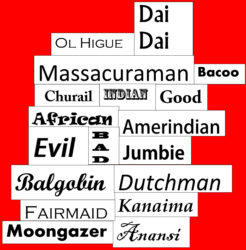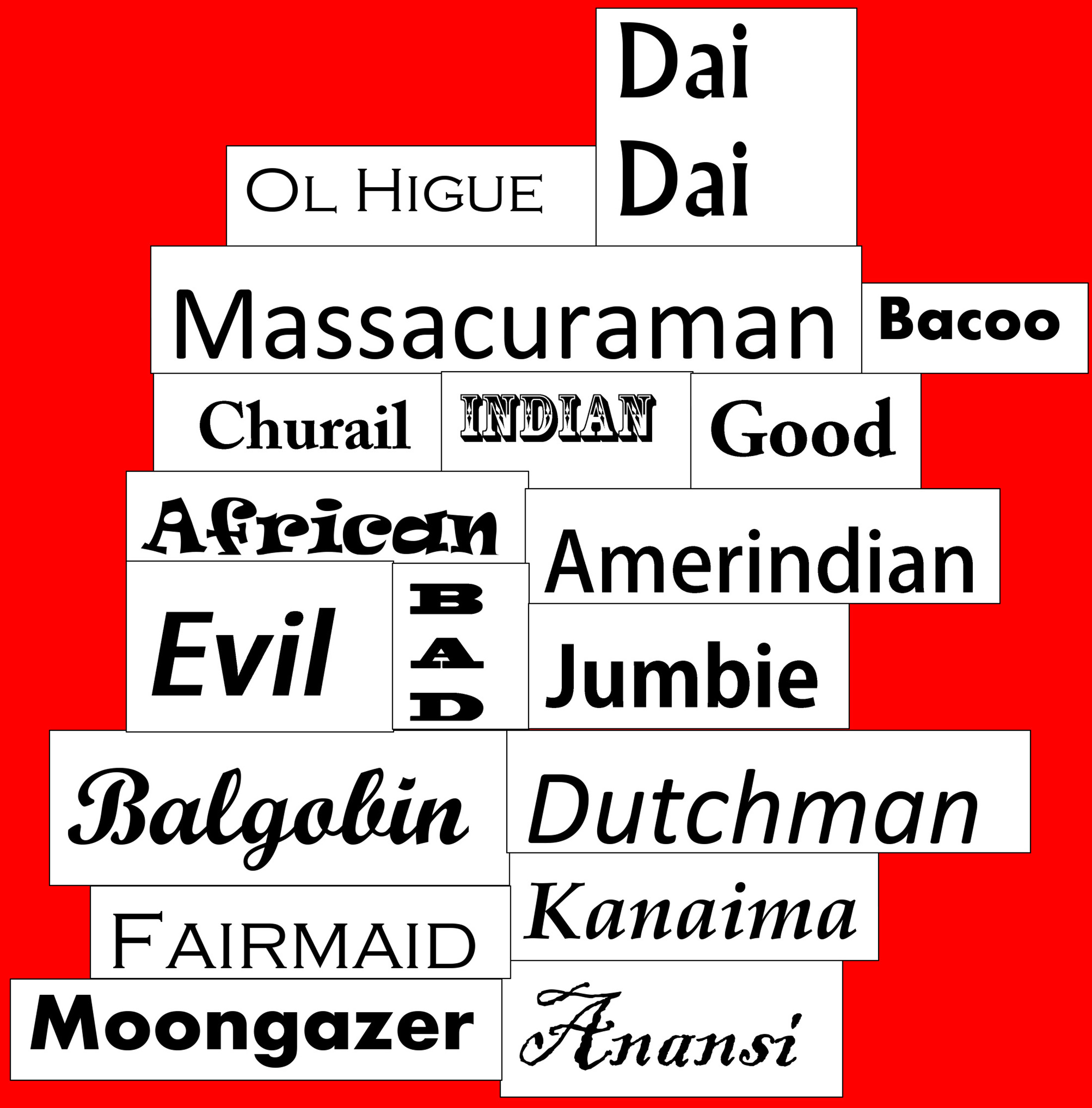One kill Polly,
Polly kill seven
And the living was crossed by the dead.
The tree was sweet, but the root was sweeter.
I shot what I saw and ate what I should not
And by the words of God it was roasted.
Traditional (From a Guyanese folk tale)
Many valuable and rewarding things came out of the Guyana National Drama Festival 2016. One of them is the Secondary Schools Story Telling Category. One of the prizes was for the Best Presentation of a Guyanese Folk Tale. The performances in this category unearthed a few treasures whose value go well beyond the creativity displayed by some of the students in their exhibition of the art of storytelling. They have the great potential to take us very deep into the Guyanese folk tale. This is a gold mine for research into a largely undocumented area.
 In 2016 one of the prize winners came from Annandale Secondary School with the performance of a story called Sheep Miner: Night Time Gaff with Nana (sheep minder). The story was adapted and dramatised by the school’s drama teacher Renita Dindyal and performed by her student Aliyah George. The important thing is that Mrs Dindyal is a graduate of the University of Guyana English programme including the study of drama, and she collected the story in the field. The greater value of it is that Mrs Dindyal’s research has discovered a rare story from the Guyanese East Indian folk tradition – a corpus of oral literature rarely heard about and struggling to survive.
In 2016 one of the prize winners came from Annandale Secondary School with the performance of a story called Sheep Miner: Night Time Gaff with Nana (sheep minder). The story was adapted and dramatised by the school’s drama teacher Renita Dindyal and performed by her student Aliyah George. The important thing is that Mrs Dindyal is a graduate of the University of Guyana English programme including the study of drama, and she collected the story in the field. The greater value of it is that Mrs Dindyal’s research has discovered a rare story from the Guyanese East Indian folk tradition – a corpus of oral literature rarely heard about and struggling to survive.
In 2015, another teacher from North Georgetown Secondary wrote Cinderani, another prize-winner in the Story Telling Category, which was also performed by a student – Melina Sukhu. The interesting thing was that the teacher, Marva Langevine, wrote that story as a Guyanese adaptation of the age-old European fairy tale Cinderella. The best part of it was that it was a Guyanese East Indian adaptation which very imaginatively, and with telling humour, turned Cinderella into Cinderani. Ms Langevine set the story in modern Guyana, narrated by a heroine whose dream tale ends her up in England, from where the English version of the fairy tale came to the Caribbean.
There are two other very interesting factors in these stories. Both the adaptation from the traditional, and the original script which draws on the traditional, are Guyanese East Indian, and they are both hybrid – a mixture of the European and the indigenous Guyanese. This hybrid factor is extremely important in the Caribbean folk tale. Research has been finding how really deep-rooted it is in the Guyanese folk tale.
Take, for instance, a tale from the African side, which we will call One Kill Polly. It also comes from a rare breed, not heard much of these days and in danger of disappearance. This one was collected in the field – in Ann’s Grove, a village on the east coast of Demerara in 2013 by University of Guyana English students researching and studying Oral Literature.
Such folk tales have clearly become an endangered species. On the other hand, the indigenous Amerindian folk tales and myths had been very well documented in the past, but not much is forthcoming from Amerindian informants in the field today. Research has been in progress with successive groups of university students at Turkeyen over the past five years, but indigenous stories from both the Indian and the African heritage have not been in bountiful supply. This is in relation to the Anansi stories, as well as “Nansi Tori” (quite a different form) and the likes of the ‘Balgobin tales’. These are hardly ever told and have to be searched out.
What, however, has been dominant in the types collected are what we have labelled “personal testimonies”. These are stories told by informants covering a range of types and narrated by persons who insist that they are true stories or experiences. Most of them are spiritual – tales of the supernatural, experiences with the supernatural, and include ‘Jumbie’ stories, Dutchman tales, and encounters with Ol Higue, Bacoo and Fairmaid.
One Kill Polly is therefore rare but very typical of a Caribbean folk tale in this context. It falls in the same genre as the Anansi stories and indigenous folk tale. It is hybrid and mixes different traditions, in particular it has a strong European derivative, and might even be an adaptation, just like so many of the Anansi stories.
The informant is a resident of Ann’s Grove, but he heard the story many years ago from a porkknocker while he was working in an interior location. Interestingly, despite its origin, it is not the usual porkknocker tale, but more in the form of a Guyanese folk tale.
The story starts with a king who decides that his daughter needs to get married. The princess, however, had little interest in marriage, and was more preoccupied with learning. She liked to read and taxed her father’s adviser to bring her books with which she spent her time. She resisted the idea of a wedded life, and only agreed to it after the king promised to allow the matter to proceed according to the princess’ terms. She could not endure a boring, uneducated husband, and would only agree to marry someone who was her equal or who was more intelligent than she was.
So the king sent around a proclamation for suitors to come forward. However, they would only get to marry the princess if they could present her with a riddle or a parable that she could not solve or interpret. The king attached a grave condition to the challenge, because if the suitor could not stump the princess – if she was able to defeat him, he would be taken away and beheaded. Needless to say, several came forward and failed.
In a country village far away from the court, the news reached a youth who was brilliant, but very poor, living in extremely humble conditions. He worked hard to support himself and his mother, but spent as much time as he could reading and learning as much as he could. The royal proclamation intrigued him and he said to his mother “Mama, ah going”. She was very distressed and tried her best to dissuade him. So many noblemen had gone and failed. Her son was only a poor boy and not in the league of all those princes and peers, and she was sure he would only go to his death. When she could not convince him, she wished him well and gave him one bake to eat on the journey.
It took him a long time, but he arrived at the palace and made his bid. The king was impressed and quite liked him and thought it would be a pity for such a brave youth to have to go to his death. The king tried hard to tell him to change his mind and walk away free. But the young man was determined and confident. He challenged the princess with the following:
One kill Polly,
Polly kill seven
And the living was crossed by the dead.
The tree was sweet, but the root was sweeter.
I shot what I saw and ate what I should not
And by the words of God it was roasted.
She was baffled. Try as she might she could think of no interpretation. The advisor came to her rescue and proposed that she be given one night to come up with a solution. The king agreed and the lad was feted and given a room in the palace for the night. All night the princess and her advisers searched and dug up all they could but by next day could find nothing. The loyal advisor tried again and informed the king that this pretender was unsuitable because he was not a nobleman, but a poor commoner and should therefore be disqualified. But the princess, too, quite liked him and said it was only fair to give him his deserved victory.
So they were married. A little while later, she confessed to her new husband that she was overcome with curiosity and was burning to hear the interpretation of his parable. The young man had a confession of his own – it was no riddle, it was just something that he made up. It was actually the story of his adventures while making the journey from his village home to the court.
His mother was distraught, and thought she could not allow him to go to a cruel death if he failed to challenge the princess, so she gave him one bake to eat on the journey, but she poisoned it. He rode their donkey named Polly on the journey. When they came to a river, he decided to give the donkey the bake since the beast needed energy to take him across. Polly was poisoned, but just managed to swim over to the other bank. The dead donkey was then eaten by seven crows who promptly dropped dead from the poison. (One kill Polly / Polly kill seven / and the living was crossed by the dead.)
Continuing on foot, he became hungry and climbed a tree to pick fruits which rescued him. But when he returned to the ground he found a pot of gold at the root of the tree. (The tree was sweet, but the root was sweeter). When he got hungry again he saw a bird which he shot, but could not eat it for want of cooking opportunity. All he could do was to take the Bible he was travelling with, tear out the pages to light a fire by which he roasted the bird and ate it. (I shot what I saw I ate what I should not and by the words of god it was roasted.)
The princess was moved and impressed. She forgave her husband’s mother and invited her to come live in the palace. He became a very wise prince, and, of course, they lived happily ever after.







